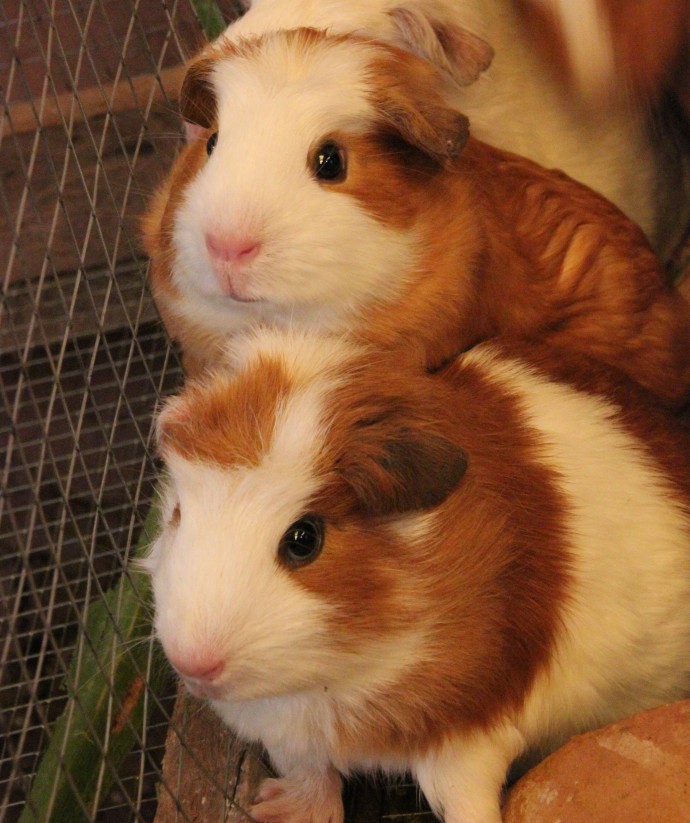 If you’re going to eat guinea pigs (and in Peru, you’re going to) you’re going to have to raise guinea pigs. Which plenty of Peruvians do, in their kitchens, in their sheds, in a random, atomized way.
If you’re going to eat guinea pigs (and in Peru, you’re going to) you’re going to have to raise guinea pigs. Which plenty of Peruvians do, in their kitchens, in their sheds, in a random, atomized way.
To an agro-ecologist like David Rocca, who coordinates Heifer’s “Good Living” IMAGEN (a local NGO) project in Puchyara, Peru, this represents a huge missed opportunity. To his mind, cuy equals the possibility of a commercial venture on a scale that can lift an entire community out of poverty. David is one of the unbelievably committed people working with local communities in partnership with Heifer, (like Cleida and Claudio from my previous Peru posts) who have the vision, plans, expectations, personal relationships with families, and follow-through to make real change happen. And it does take vision to look at a guinea pig and see the cash rolling in.
But here’s how it happens: When David started to work with Sebastian and Elena Huillca (and their three children), the family had 2 donkeys, 4 cows, 1 horse, a passel of guinea pigs in a rough shed, and a piece of land one hour ‘s walk away. The house was a mess and the yard was worse. In Heifer workshops, the family learned a few new habits that literally changed their life. They established a Healthy Homeand gave each child his/her own room.
They built a shed for their animals, collected the manure that was now in one handy place, and with the help of some industrious Heifer worms, used that compost to fertilize their new bio-garden where they grow enough vegetables to eat and to sell in the local market.
The family planted fruit trees. They learned how to use local clay to plaster (and beautifully decorate) their house, instead of buying expensive materials they couldn’t afford. And in the guinea pig shed, they covered the walls in clay (with happy drawings), built compartments to separate males, females and babies, grew better forage to feed them, and began keeping breeding records to control reproduction and improve genetics.
The Huillcas followed David’s teachings and put ashes in the entrance of the house to kill bacteria, used meds to treat sick animals, and bred the gift of new Heifer guinea pigs with the local stock to double the weight of their piggies. One year later, they’ve both doubled the number of their pigs, and the price they get per cuy at market. (And both their daughters are attending college!)
David is such an ardent believer in the potential of guinea pigs, he contends that profits will begin to repay Heifer’s investment in 2-3 months (including passing on the gift). And his math works. Guinea pigs are ridiculously fertile; females can have 3 pregnancies a year, and the better the feed, the quicker the baby comes. What David has taught his farmers is that if they take care of their guinea pigs— guinea pigs will pay off– big time– for the whole family.
Cuy is served in almost every restaurant in Peru, from sidewalk cafes to the swankiest eateries, so the demand is virtually unlimited. Its meat is high protein, low cholesterol and supposedly truly delicious (that’s right, I wimped out).
And unlike bigger animals that demand grazing and herding, guinea pigs can be raised on small plots of land, and handled by older beneficiaries like Felipe Ayachu, who is trying to keep his farm running despite an illness, with only his devoted daughter to help him.
David’s also inspired enthusiastic spark-plugs like Dolores Delgado – whose sterling example of taking the guinea pig ball and running with it has been so inspiring, she’s moved her community’s Heifer involvement from 3 families to 35 (out of 40!)… built a whole new guinea pig barn and organic garden, and doubled the price of the town’s pigs! It’s what she promised Heifer President Pierre Ferrari she would do when he visited Puchyara last year, a meeting she remembered with overflowing tears and copious hugging.
In fact, it’s the example of Heifer beneficiaries like Dolores, Felipe, and Sebastian who start showing up with big, fat guinea pigs for sale, their homes shining with fresh clean designs, and their gardens bursting with produce, that catches neighbors’ attention and spurs participation in the project. These early adopters have become Heifer/IMAGEN promoters, their communities have organized, and now David has the success stories and community backing to intercede with municipal authorities to continue to invest in the materials, seeds and structures that will make Puchyara Pigs the toast of nearby Cusco.
A succulent cuy may never pass my lips, but I predict that before long, David’s dream will be a yummy roasted reality.

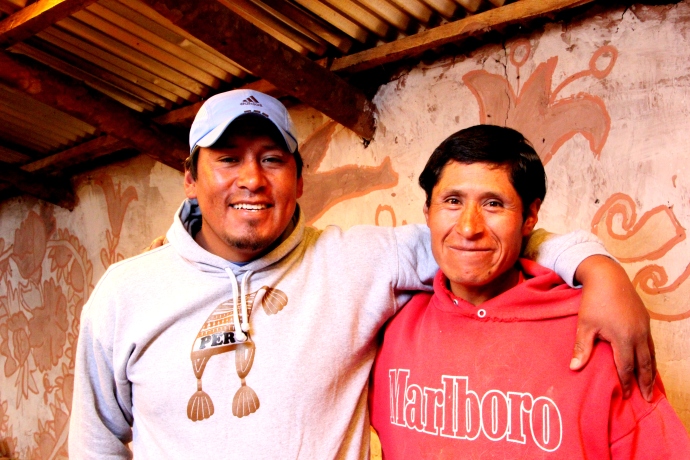


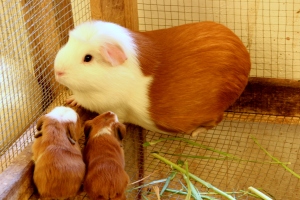

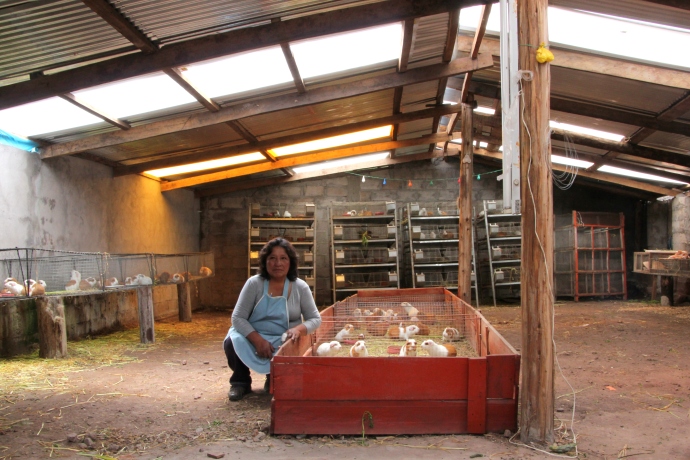
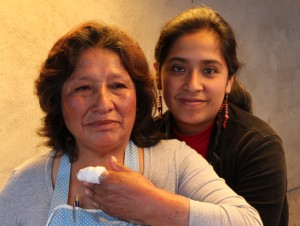






I love the gorgeous guinea pig shed! Yet another amazing turnaround due to Heifer’s intelligent giving and people determined to make the best of everything they have. Thanks, Betty!
hahahaha wow, you’re crazy. You know that hamsters eat their own young you aren’t gtntieg on their backs now are you? What do you think guinea pigs should be used for locking them up in cages as pets?
The really sweet & shy 12-year old Huillaca boy painted most all those adorable drawings .. and the beauty of the plaster is that instead of them paying hundreds of dollars for it, they can make it from clay from the nearby riverbed — and it’s SO pretty!! I love the Heifer teachings that are like this — imminently practical, so essential in improving the health and happiness of the families, and really giving them a chance to succeed. I adored this family and was really moved to think that although neither the mom or dad was educated at all, their two daughters were going into the professional world — just AMAZING and that’s what I think creates these huge leaps forward in one or two generations … love you, Sarah!!!
I have not heard of anyone else eating guinea pigs, but I think you should try it while you are there, Native Americans would eat almost anything, so it’s not that suprizing, we used to raise rabbits for meat and fur, yes they are cute, but you get over that in a hurry and it’s just food…Many birds that we eat are pretty, and cows can be very cute. Much of what is eaten is determined by cultural norms, and religious beliefs. Try not to be overly Americanized and let yourself experience international adventure, isn’t that why you are doing this, after all?
teresa hart
Hi Teresa ! Well, luckily the cuy wagon has passed me by, as I’m in Nepal right now — and I have to say, I LOVE their food (dal — lentils and a bunch of super yummy veggie dishes are my faves!) But oh yeah, I am overly Americanized and I totally avoid meats that I find suspicious or squirm-inducing (as well as fish, btw). China was a whole merry-go-round of things I refused to try, for instance (but I took great pictures so you can see what I missed). Expanding my culinary limitations isn’t why I’m doing this — that ship sadly sailed a long, long time ago — I’m just here to see the people. And that’s been completely dazzling! Thanks for the comment, Miss T!!!
Betty
Being a one time veggie I can understand the meat turnoff, I’m sure you are smart enough to inform your host of your not meat diet so they won’t be offended when you turn down there meals…And yes now you mention it I can think of lots of things the chinese eat that my tummy would reject , like a variety of bugs, including mealworms, which are high in protein, but would not be on my plate unless I was starving for weeks. Napal diet sounds yummy, looking forward to pics.
teresa
This sounds like a fabulous project, but I’m like you, Betty, I couldn’t eat one–I don’t think. I’d have to be ridiculously hungry. Love the wall art inside the shed. Fascinating post–interesting to know about a culture with guinea pig cuisine.
Hugs,
Kathy
I am so glad you’d be equally wimpy about eating cuy, Kathryn. What I’ve learned about myself is that there is really no point in trying to expand my culinary boundaries when it comes to meat because I’ve never liked meat — so whether it’s llama (which I did try a tiny bit of & it was okay) or alpaca or cuy .. I’m highly unlikely to suddenly overcome a lifelong aversion to meat. And how about that beautiful art done by the son?? So sweet!!
This must be how people feel when they see pictures of my sweet calves :S ! So glad they are on the road toward self-sufficiency… nothing better!
ABsolutely .. CMW! And the one thing that this travel has taught me is how completely removed most of us Americans are from the source of our meat — and food of all kinds — and it’s really disrespectful. I’m sure you have a much more balanced view of that, being so close to the land, the animals and the natural cycle of life — REALLY appreciate your comment & love your blog!!
First time I have seen a guinea pig. I don’t eat any type of pig but just like Kathryn, I loved the paintings on the walls.
It really warms your heart, doesn’t it, Jackson?? I think it shows how proud the family is of the structure, and their work — very touching!!
You didn’t really miss anything by not eating the cuy; I tried it when I was on a Fulbright to Ecuador, and I’m not a fan! However, it’s a great source of protein and works well in certain areas. I love following your blog and reading stories of the families whose lives have been transformed through Heifer.The photos are awesome; keep up the good work!
Judy Huynh
(friend of Jackson Kaguri)
Thanks so much, Judy – and any friend of Jackson’s is a friend of mine!! So happy you’re along for the journey — and since Heifer has honored Jackson, I’m super happy we’re all in the same big FAN club!!
All I can say is OMIGOSH and amazing!
Amen to that!
I couldn’t bring myself to try the cuy either! I have a funny guinea pig story I’ll have to tell you some time!! 🙂
Oh, Sherry — can’t wait to hear that one! Your travel stories are always great!!
Cuy or no Cuy… hmm.. that IS the question..that would be a very difficult decision if visiting Peru someday I guess… since I am kinda adventorous when eating out… they are SO ADORABLE!! when I saw the shelters I just imagined myself going in and picking some up!! Although I personally know what you think of the poor things… does the same thing that happen with cute bunnies, happen with cuys for you?
Well, its great that these little animals can provide not only nourishment for families but also instant income. Is Peru the only South American country eating guinea pigs? I`ve never heard of that anywhere else…
I looove your stories, keep on writing!
Take care and be safe
Vivian
Vivian — thanks so much for your great comment! And yes, people all over the developing world eat rabbits but the only place I’ve seen them eat guinea pig is Ecuador & Peru (although Bolivians might, as well). I do think it’s a great source of protein for the people, it’s super inexpensive and seems to be a pretty good clean meat — but as for me, I don’t think so. Am really happy you like the blog!!!
Oh my. Love the post but am a bit squeamish about eating the product. They are just too darn cute.
I’m kind of the opposite, Renee — guinea pigs are way too much like mice & rats for me to have any reaction except total squeamishness — and that’s when they’re in the cage, not on my plate!
Sad to admit, but I’m one of those jump-on-the-table-and-scream-hysterically females when it comes to any kind of rodent — which is weird cause it’s just about the only thing I am afraid of. OMG!!!!!! JUST AS I WAS WRITING THIS, A MOUSE RAN ACROSS MY TOES AT THE RESTAURANT IN NEPAL WHERE I AM SITTING AND WRITING THIS — who says we don’t attract the things we fear??? Jeez, Louise — I’m shaking!!! So back to guinea pigs/super furry mice and eating them? Totally out of the question!
Hi Betty,
Yet another fabulous successful story a la Heifer International. My Catholic background informs me that the Holy Spirit moves through these people and communities in an utterly divine and prolific fashion. Talk about inspiring.
It is so easy to think how quickly I would never eat a Cuy, but the fruits they bare to families and communities is humbling and amazing. The people you chart weekly are the everyday foot soldiers of Christ who understand the power of work, faith and hope!
Thanks for your wonderful stories and fabulous pictures.
Hugs!
Ginger
Yes, Ginger I totally agree — some of the most humble families I’ve met on this journey have been the most inspirational in that they work so hard, are so patient and hopeful, and exhibit such gratitude for the little they have … it’s just a great life lesson for me, and hopefully for my readers, too. I wish that we in America who have SO SO much would stop being so hateful to each other and mean-spirited in our public discourse, and learn from these communities who are so cooperative and sharing!
woooooh… ^_^ this is good…this is the first time ive heard that this type of animal can be eaten…. because here in the philippines…. it is a pet at home and we dont eat them…. anyway your work is outstanding–for *any* age! Beautiful.
Thanks so much, Robi! I think it’s only Ecuador and Peru where they eat guinea pigs .. they are pets here in the USA, too .. but I’m so happy you like my blog!! Love that you’re a photographer, too!!
They are too cute, and I love the paintings on the walls. It’s funny how we are about food. I am half Filipino, so there are certain things that I have absolutely no problem eating because I grew up with it (like blood pudding, goat, and even fried pork intestines – I KNOW!). I was in a fancy French restaurant once and I ordered the rabbit to try it, because I like trying new things, but not realizing it would be served on the bone. One look at those little legs on my plate (much like your cuy picture from an earlier post), and my stomach did about seven somersaults as I pushed the plate away. I do flip flop back and forth between wanting to be vegetarian for health reasons, and other times wanting and craving a juicy red steak. Plus I love bacon, sigh. I respect your food choices and I think that you are doing an amazing job of describing the culture, people and the project with an unbiased voice. The mutual respect and admiration that you are cultivating as an ambassador for the project is really to be commended. Great job!! Love your blog 🙂
Thanks SO much, Rufina — I take it very seriously how I respond to people about food and cultural norms because I LOVE these societies and feel so honored to be invited into their community that I would hope to never insult their generosity, particularly considering they are sharing with me from a position of having almost nothing – and that is VERY humbling. I try to never openly reject something; I’ll just eat the vegetables or fish and skip the meat. It’s not that I’m an ardent vegetarian — but meat can be very sketchy in these countries (as well as ours, btw) and I can’t afford to get sick. One of my best friends got amoebic dysentery from eating meat in Nepal and not only did she almost die – her health, twenty years later, is still utterly compromised. So … I just choose not to eat meat in a quiet, uncomplaining way. I’m SO happy that you like my blog and I really am grateful for your comment!!
Kinda makes one wonder why we waste so much land and energy on cattle.
Amen to that Sybil! Cows are a huge investment for a lot of poor people – although they provide lots of milk and labor, they take a long time to reproduce (4 years) and require a LOT of food to grow. That’s why David was such a huge cuy advocate – he could get quick, impactful results in 6 months!
After reading your post I said “oooh yuk they eat guinea pigs in Peru”, and my daughter (who’s visiting us at the moment) told me about her Peruvian born friend Ro who though a vegetarian, eats guinea pig her grandmother cooks in their Toronto home. Oh well…
I know .. it’s a big leap of faith to imagine eating a little guinea pig, but every country has its unusual cuisine, that’s for sure.
Wait til I write about Chinese specialties!!! Thanks, Rosie!
oohh… i know some chinese foods… ^_^ we own a Chinese store in the Philippines… ^_^
Pingback: Just When You Think That’s Enough, DO MORE! | Heifer Blog
Pingback: Deep Thoughts About Peru… | Heifer 12 x 12
Woke up in the middle of the night panicking about something ( I think Louie the cat was teasing the G. Pig) and found your blog quite by accident. This is an amazing, thought provoking chronicle that you provide here. The pictures and people are gorgeous and awesome and it really did assuage my panic attack. I’ll keep reading because what you have here is so valuable and inspiring. Thanks a bunch!!! Not that I am going to eat these small critters any time soon since I am really trying to go meatless. Regards, Judy
Thanks so much for this comment, Judy — and I’m glad I could provide some late-night reading! I love that you found it inspiring, as it certainly was an amazing journey for me, and the people I met were constantly giving ME hope for the future! Happy reading!!